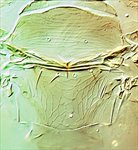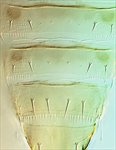Generic diagnosis
Female macropterous. Head wider than long, interantennal projection broad; maxillary palps 3-segmented; eyes without pigmented facets; ocellar setae I present; setae III short; four pairs of postocular setae. Antennae 6-segmented, segment I without paired dorso-apical setae, II with one inner dorsal apical seta longer than outer seta, III and IV with sense-cones forked, III–VI with microtrichia on both surfaces. Pronotum wider than long, with transverse anastomosing striae; no long posteroangular setae; four pairs of posteromarginal setae with S2 longest. Mesonotum with transverse striae; median pair of setae situated far from posterior margin and anterior to submedian setae; anteromedian campaniform sensilla absent. Metanotum reticulate; campaniform sensilla absent. Fore wing first vein with long gap in setal row; second vein with four setae; clavus with four veinal and one discal setae; posteromarginal fringe cilia wavy. Prosternal ferna weakly divided medially; basantra membranous, without setae. Mesosternum with sternopleural sutures reaching anterior margin; endofurca with spinula; spinasternum narrow and curved posteriorly at middle. Metasternal endofurca with spinula. Tarsi 2-segmented. Tergites without ctenidia or craspeda, not clearly distinguished from laterotergites; tergites I–VII with S1 setae wider apart than their length; II–VIII with closely spaced rows of ciliate microtrichia on lateral thirds; VIII with posteromarginal comb complete; IX without campaniform sensilla; X without median split. Sternites with numerous ciliate microtrichia on lines of sculpture laterally, without discal setae or craspeda; III–VII with three pairs of posteromarginal setae, II with two pairs; sternite VII with all setae at posterior margin.
Male similar to female; tergite IX with pair of drepanae.
Biological data
The only species in this genus is sometimes considered a minor pest feeding and breeding on the leaves of grape vines, Vitis vinifera [Vitaceae]. However, in England it has been taken in large numbers (Palmer, 1986) from high in the canopy of Quercus [Fagaceae].
Distribution data
Apparently widespread across the Holarctic.
Nomenclatural data
Drepanothrips Uzel, 1895: 213. Type species Drepanothrips reuteri Uzel, 1895, by monotypy.
Only one species is placed in this genus (ThripsWiki, 2020), and this is recorded in northern China:
reuteri Uzel, 1895: 213.
Relationship data
Thripidae sub-family Thripinae: this is a diverse group involving more than 230 genera. In structure and biology, both sexes of Drepanothrips reuteri are closely similar to species of Scirtothrips but have the last three antennal segments fused to form a six-segmented condition.
References
Palmer JM (1986) Thrips in English oak trees. Entomologist's Gazette 37: 245–252.
ThripsWiki (2020) ThripsWiki - providing information on the World's thrips. <http://thrips.info/wiki/Main_Page>
zur Strassen R (2003) Die terebranten Thysanopteren Europas und des Mittelmeer-Gebietes. Die Tierwelt Deutschlands 74: 1–271.



